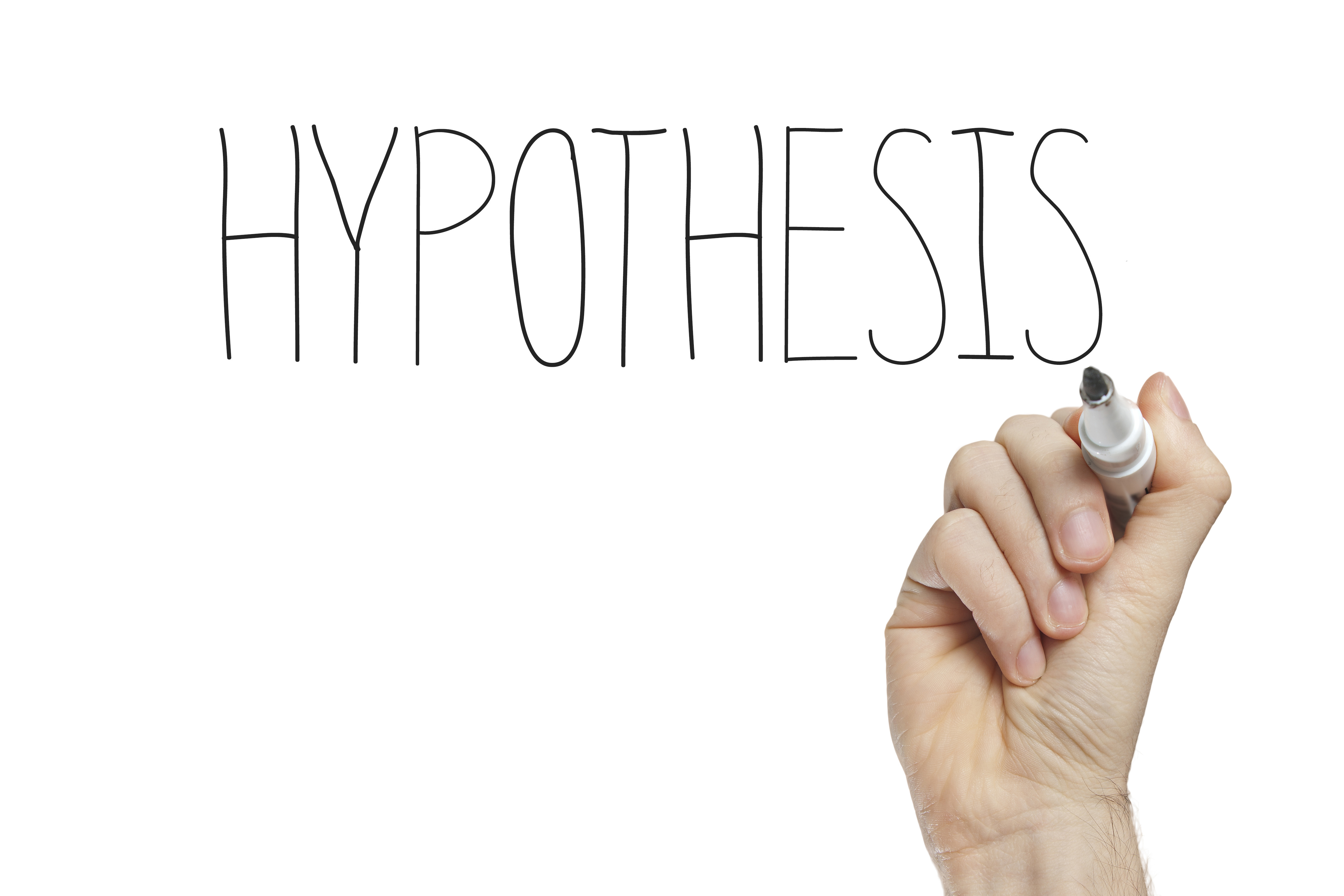Understanding linear regression
Regression represents one of the cornerstones of machine learning. Comprehending its logic and math provides a solid foundation for learning more advanced machine learning techniques such as neural networks.

Linear regression is a statistical method for modeling the relationship between variables. It’s used for analyzing dependencies and predicting values.
The underlying idea of linear regression is simple: given a dataset, we want to find the dependency of one of the variables in the dataset on one, some or all of the other variables.
If we notate the dependent or target variable as y and the independent or explanatory variables as x what we’re looking for is the function
$$ y = f(x) $$
that, given an arbitrary value for x, outputs the desired target variable y. The output represents our prediction for y. It’s an estimation of the unknown actual value of y.
This function is also referred to as our model. We’re modeling the relationship between and or, more specifically, the dependency of y on x.
The dependency is learned from a dataset. The dataset is simply a large collection of examples of x recorded in the real world. These examples are used to train the computer to estimate the target function and hence called training examples.
Each training example may consist of just one or many explanatory variables plus their respective “to-be-predicted” target variable y. It’s typically a many-to-one relationship, i.e. many independent variables are mapped to a single dependent variable.
The objective of linear regression is to have the computer learn dependencies inside the data simply from looking at many examples. Each example must include the correct or desired output for the respective inputs, also referred to as the ground truth.
This type of learning is therefore called supervised learning. By providing correct examples of y we’re supervising the learning algorithm.
The Methodology
Linear regression, or regression analysis in general, consists of 3 steps: define a hypothesis function, define a cost function and run an optimization algorithm.
Before explaining these components in detail, let me briefly address a hurdle that many people face when learning regression or machine learning in general: the math.
If you don’t have a strong math background a series of equations presented in a tutorial or paper may present an immediate turn-off. I know. Why is that so?
Math is a language, the language of nature. Unfortunately, the average reader is not fluent in or familiar with this language. Mathematical equations therefore easily get intimidating because they may include unknown signs or greek letters.
Let’s go step by step through the math, and you’ll see it’s not that hard at all. Especially if you’re a software developer and used to systematic thinking.
Mathematical Notation
A dataset consists of a number of training samples. Typically, the more the better. Let’s define or notate the size of the dataset as m:
$$m = \text{number of training examples in the dataset} $$
Every training sample consists of a number of independent or explanatory values, called features. Let’s notate the number of such features per training example as n:
$$n = \text{number of features per training example} $$
Then let’s pack all of these features of a single training example into a vector. In this context a vector can be regarded simply as a list, or array, of values. Let’s notate this vector as x:
$$ x = [x_1, x_2, ..., x_n] $$
The subscript index denotes the j-th feature of a training example, where
$$ j \in \lbrace 1..n \rbrace $$
But of course there are many training examples, not just a single one. Therefore, we will use another index, a superscript i, to denote a specific training example i, where
$$ i \in \lbrace 1..m \rbrace $$
A specific training example, with all its features, is then denoted as vector
$$ x^{(i)} = \text{n-dimensional vector of all features of the i-th training sample} $$
Combining both, the value of a specific feature of a specific training example is denoted as:
$$ x_j^{(i)} = \text{value of the } j^{th} \text{ feature in the } i^{th} \text{ training sample } $$
So far so good. That wasn’t so hard.
Now, what’s missing? To compute, or estimate, the target variable linear regression weighs each individual feature differently and then adds up all the weighted features.
These weights are called the parameters and are notated with the greek letter “Theta”:
$$ \theta $$
Every feature gets weighted differently. The number of parameters that we’re trying to find is therefore the same as the number of features.
But we don’t compute separate parameters for each training example. What we want is a single model, one function that covers all of the training examples. So let’s pack the parameters into a vector as well and denote this vector as:
$$ \theta = [\theta_1, \theta_2, ..., \theta_n] $$
Great. That’s all we need. Now, let’s get started with the 3 steps methodology mentioned above.

Hypothesis Function
Regression attempts to model an unknown function h that maps the given inputs x to an output value y. Let’s call this our hypothesis function and denote it as
$$ h = f(x) $$
Again, there could be a single input value x or many input values. (Remember, x is a vector and this vector may have a size of 1 which would make it a scalar.)
Depending on the number of explanatory variables x, we distinguish 3 types of linear regression:
- If there is only a single input variable or feature x, we call the model a uni-variate linear regression:
$$ h_\theta(x) = \theta_0 + \theta_1 x $$
- If there are multiple input variables or features x, we call the model a multi-variate linear regression:
$$ h_\theta(x) = \theta_0 + \theta_1 x_1 + ...\ \theta_i x_i \ ... + \theta_n x_n $$
- If the independent variables or features include exponentials, we call the model a polynomial linear regression:
$$ h_\theta(x) = \theta_0 + \theta_1 x_1 + \theta_2 x_1^2 + \theta_3 x_1 x_2 + \theta_4 x_2^2 \ ... $$
Math and methodology are the same for all three.
You may have noticed that I added an additional parameter
$$ \theta_0 $$
The reason is that the function that we’re trying to find may have a certain base value that is completely independent from any of the features. This base is also called the bias.
Since there is no feature mapped or related to the bias, we set the corresponding
$$ x_0 = 1 $$
Having added the bias parameter to our feature vector x and to our parameter vector 0, both vectors become of size n+1.

Cost Function
After we defined the hypothesis function, we can feed data into this function and it will return a prediction or an estimate of what the output value y should be for a particular set of inputs. But how good is this value computed via our hypothesis?
We need to measure the accuracy of our hypothesis. We do so by computing the difference of the hypothesis with the actual “true” target value from the dataset. (Remember from above that in supervised learning we need to provide the target value for each training example.)
Since there are many training examples and not just a single one, we can measure the difference for each. That’s what a cost function does.
The difference of hypothesis and target is called the error or cost or loss.
Conceptually, there are many different options how to measure or express this error. The most common method is to compute the mean squared error (MSE) and is defined as follows:
-
compute the difference of hypothesis and correct output for a particular training example i,
-
square the difference,
-
sum the squared differences across all m training examples, and then
-
divide the total by m to get the mean (average) cost.
Mathematically, we’ll denote this kind of cost function J as
$$ J (\theta_0, \theta_1, ..., \theta_n) = \frac{1}{2m} \sum\limits_{i=1}^m (h_{\theta} (x^{(i)}) - y^{(i)} )^2 $$
and read it as “J with respect to Theta 1, ... Theta n” stating in brackets the variable(s) that we’re minimizing for (i.e. Theta).
Next, we want to minimize this cost function, i.e. find those parameters or those values of 0 that result in the minimum J.
Minimizing the cost is an optimization problem: we want to find the optimal representation of
$$ h(x) $$
which leads us to the third and last step in the methodology for linear regression.
Before we do that, a short side note. You probably noticed that in above formula for J we’re actually dividing by 2m instead of simply by m. This is done for mathematical convenience later (when computing the derivate). Since it doesn’t impact the minimization it represents a valid simplification.
At this point it may also be worth noting that in addition to mean squared error there are other possible cost functions, e.g. one could compute the mean absolute error or the average cross entropy.

Optimization Algorithm
To find the optimal hypothesis we need to minimize the error or cost. The optimal values for our parameters Theta will result in the lowest cost or lowest value for J.
There are different ways to do this. The most popular optimization algorithm is called gradient descent.
Gradient Descent
The idea of gradient descent is simple:
-
Compute the slope at an arbitrary point of the cost curve.
-
If the slope is bigger than 0, slightly decrease the input values, i.e. pick a new point a little further to the left on the cost curve.
-
If the slope is smaller than 0, we slightly ** ** our input values, i.e. pick a new point a little further to the right on the cost curve.
-
Repeat these steps until the slope is so small that there is hardly any further reduction or improvement.
Let’s see how to do this mathematically.
The slope of a curve is computed via the derivative of the underlying function. That’s easy. But our function does not have one but multiple features and the same number of parameters. Hence we need to compute the partial derivate for each of those parameters.
Gradient descent incrementally updates the parameters in our cost function using two components: the gradient and a step size.
The partial derivative (“delta”) of the cost function J
$$ J (\theta_0, \theta_1, ..., \theta_n) = \frac{1}{2m} \sum\limits_{i=1}^m (h_{\theta} (x^{(i)}) - y^{(i)} )^2 $$
with respect to parameter
$$ \theta_j $$
is called the gradient:
$$ \frac{\delta}{\delta \theta_j} J (\theta_0, \theta_1, ..., \theta_n) = \frac{1}{m} \sum\limits_{i=1}^m (h_{\theta} (x^{(i)}) - y^{(i)} ) \ x_j^{(i)} $$
This gradient is used to update or change the parameters. It will be subtracted at an arbitrary “step size” called the learning rate alpha:
$$ \alpha $$
So, we simultaneously update all parameters
$$ \theta_j \text{ for } j \in \lbrace 0..n \rbrace $$
via the following formula:
$$ \theta_j := \theta_j - \alpha \frac{\delta}{\delta \theta_j} J (\theta) = \theta_j - \alpha \frac{1}{m} \sum\limits_{i=1}^m (h_{\theta} (x^{(i)}) - y^{(i)} ) \ x_j^{(i)} $$
Gradient descent automatically takes smaller steps when it approaches the minimum because the slope gets flatter.
There are 3 types of gradient descent:
-
batch gradient descent = each step uses all training samples (=> computationally expensive)
-
stochastic gradient descent = each step uses only a single sample
-
mini batch gradient descent = each step uses an arbitrary mini-batch size of training samples
Batch Gradient Descent
Batch Gradient Descent considers all training examples for each optimization step. It directly converges to the global minimum.
Stochastic Gradient Descent (SGD)
Stochastic gradient descent considers only a single training example at a time, therefore does not directly converge but zig-zags in on the global minimum. It does not actually reach the global minimum, but “oscillates” around it.
Looping through the whole dataset only once may not be sufficient to converge to a global optimum. In practice SGD is often run 1-10 times on a given dataset.
SGD is a type of online learning algorithm because it does not require a whole dataset at once but can process training examples one-by-one, i.e. learn online.

Mini Batch Gradient Descent
Mini Batch Gradient Descent is a kind of hybrid version trying to combine the advantages of both batch and stochastic gradient descent. Instead of summing (or looping through) the whole dataset for each optimization step, the algorithm uses a randomly selected subset of examples.
Its main advantage is that it’s computationally much less expensive. It also converges faster than stochastic gradient descent because it avoids (much of) the zig-zag.
Given today’s parallel computing capabilities mini-batch is especially performant if the algorithm is vectorized.
Thanks for reading! Feel free to contact me for any questions or comments.